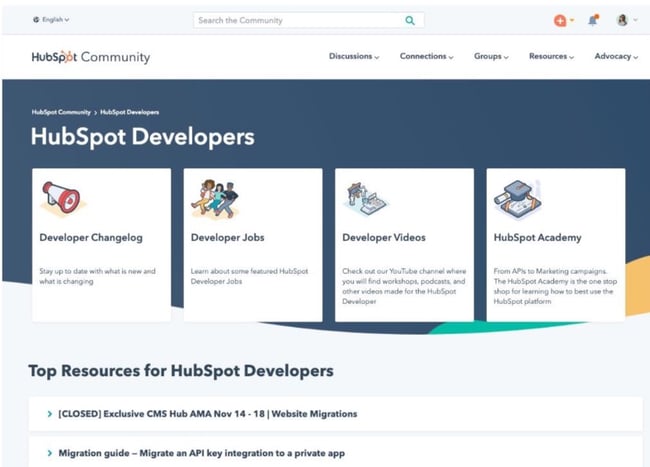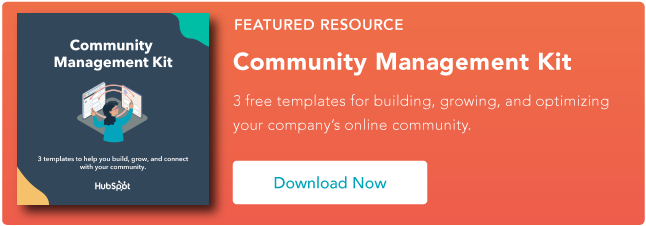When businesses invest in community management, they transition from an everyday brand to a human brand — one that cares deeply about the people who support them, work for them, and interact with them.
Businesses build communities — or implement community management tactics at their companies — to build authentic relationships among their audiences, both external (customers, followers, etc.) and internal (employees, vendors, partners, etc.)
And it works. Marketers say that having an active online community is key to success in 2023, and at the time of our Consumer Trends Survey, 1 in 5 social media users joined or participated in an online community in the past 3 months.
Let’s dive into the details of community management and how you can implement it for your brand.
What is community management?
Community management is the process of building an authentic community among a business’s customers, employees, and partners through various types of interaction. It’s how a brand uses opportunities (in person and online) to interact with their audience to create a network in which they can connect, share, and grow.
What is the purpose of community management?
Community management has become increasingly popular and recognized by all types of businesses — however, it’s still largely undefined.
So, what makes it so special? Why should your business adopt it? To answer those questions, let’s cover some main reasons why community management is critical to your success as a brand today.
“Brands need to hire community managers because they’re the tone, voice, and human element behind your brand,” said Krystal Wu, former social media community manager at HubSpot.
Community management allows your business to:
- Obtain feedback and gather ideas from your customers and audience members through real conversations.
- Provide support for audience members, fans, and customers when they need it.
- Increase brand and product awareness among your target audience.
- Learn about your customers and what they want, expect, and need in terms of content, products, services, and support.
- Build one-on-one and one-to-many relationships between audience members and your brand.
- Boost customer interactions, conversions, and sales.
- Provide value to your customers beyond a product or service.
It’s important to note community management is a broad industry — these are just some of the things community management allows your business to do.
Community management is also an umbrella term; there are many forms that live beneath it. Let’s review the different types to help you determine the best focus for your company.
Types of Community Management
There are seven main types of community management. Some are behind a screen and require no face-to-face interaction; some involve in-person interaction with you and your teams. The easiest way to review the different types is with the SPACE model.
The SPACE Model represents different types of community management — this way, you can better understand what works for your business. It stands for:
- S: Support Community Management
- P: Product Ideation, Innovation, and Feedback Community Management
- A: Acquisition and Advocacy Community Management
- C: Content and Contribution Community Management
- E: Engagement (External or Internal) Community Management
Let’s take a look.
Important note: This section is an overview of just a few of the many types of community management. We’ve also provided a couple of examples of each.
Customer Support / Success Community Management
Image Source
The first type of community management is customer supper and success. It can often be in the form of:
- A forum
- An FAQ document
- A community website
A forum, typically a question-and-answer community-based discussion board, is a great way to connect with your community, answer questions, and give community members a chance to chat and interact with each other. You can also ask for customer feedback on the channel.
Within the forum, you might share FAQ documents for community members to self-help and get quick answers to commonly-asked questions.
A customer success platform or software can help you create a branded website or landing page for your community members where you can focus on supporting them. Here, consumers can help themselves (and each other) communicate with your teams, locate necessary resources (like a knowledge base), and review your FAQ document.
A tool like Vanilla Forms can help you create and customize a community forum, FAQ document, or site page with your relevant branding, and you can manage conversations and create a space where customers can provide you with ideas.
Best For:
This type of community management is ideal for companies with in-depth product lines, like a software company, so users can communicate about tips, tricks, and issues they may run into.
For example, HubSpot’s Developer Forum is a customer support community for users looking to build on the software. Developers can stay connected with the company, other developers, and the resources they may need for working on the platform.
Product Ideation, Innovation, and Feedback Community Management
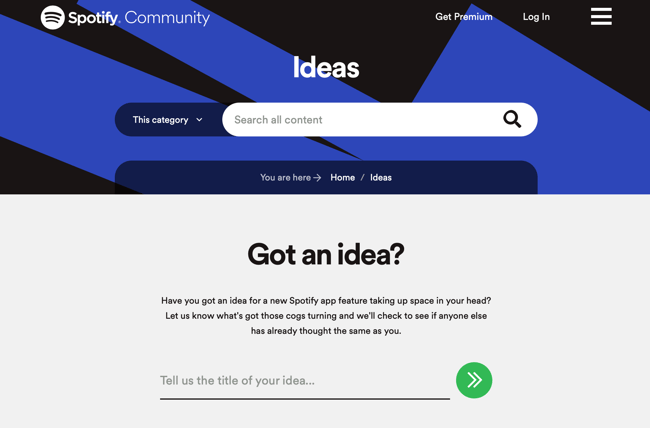
Image Source
Product ideation, innovation, and feedback is a proactive and reactive type of community management, where you create a safe space for customers and your target audience to share feedback and thoughts about how you can innovate and improve upon your products and services.
You can ask people to complete surveys or participate in in-person feedback discussions, or even organize user testing for people to take part in. For example, you might host a focus group at your office to get customer feedback on how you can enhance your product or service after people use it.
Best For:
This type of community management works for all companies — asking for feedback from real customers and users on innovation opportunities is critical to success. But it’s especially useful for consumer-oriented SaaS companies, where bugs can sometimes spiral into a reputation management issue.
Spotify’s community forum is a great example. There, users can not only discuss music, but submit product ideas for the Spotify team to review.
Acquisition and Advocacy Community Management
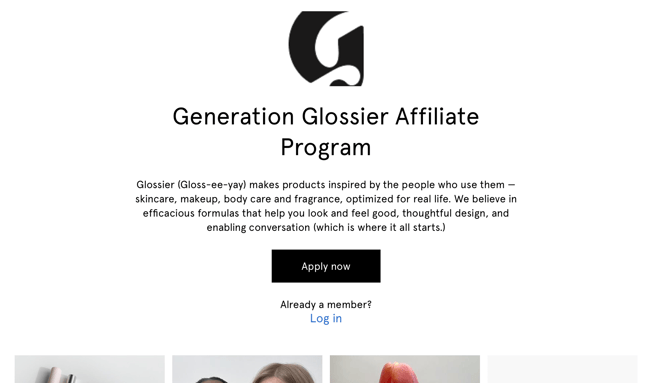
Image Source
Acquisition and advocacy community management allows you to interact directly with people excited about your business, including your leads, customers, brand ambassadors, and brand advocates.
These members will help you build brand awareness and promote your products and services through word-of-mouth, affiliate programs, and social media. A common way to create this type of community is to implement an acquisition and advocacy program like a brand ambassador initiative.
Glossier, for example, has an affiliate program where micro-influencers and bigger influencers can use Glossier products and promote them in their profiles. This then works as an acquisition model by turning affiliates into customers, and then having those customers acquire more customers on Glossier’s behalf.
Best For:
This type of community management is great for delighting your top brand advocates and keeping them at the center of your flywheel. You’ll also promote brand loyalty, increase awareness, and build long-lasting relationships with your biggest supporters.
Content and Contribution Community Management
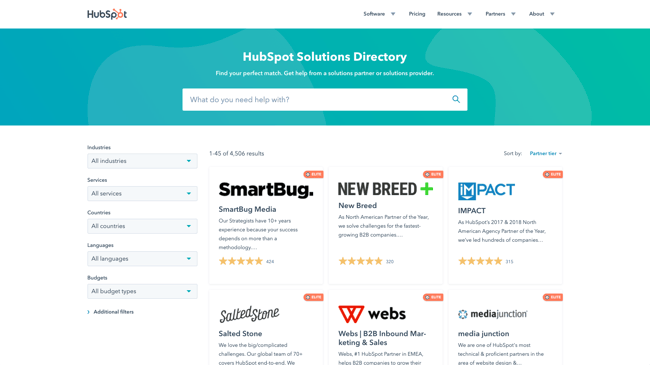
One unmissable type of community management is content and contribution, where you allow the community to contribute content on any given platform. This can include marketplaces, crowdfunding, user groups, and user-generated content.
Whether it’s allowing customers to create a listing on one of your websites, to write guest blog posts, or to create user-generated content on your brand’s behalf, content and contribution can help your customers feel seen and important.
That can, in turn, increase customer loyalty and retention.
These communities typically have a designated team that ensures all user-generated content is appropriate, follows company guidelines, and meets site requirements.
Best For:
You’ll want to use a content and contribution model if you have the resources in place to create contribution websites or if you plan to manage your community primarily on social media.
It’s also a great option for companies with contributed content at the core of its products, business model, or other assets. For example, companies like GoFundMe and Airbnb create value through the people who join their sites and use the platform to share fundraisers or rental properties.
But it doesn’t have to be so direct, either. For example, HubSpot has a solutions directory for agencies to sign up on — completely free. This is one of the many communities HubSpot maintains, and the best part is that it’s for agencies that could end up using HubSpot for its customers.
If your community will primarily be located on social media, then you can use a content and contribution model by pushing out a user-generated content hashtag. For example, stationery brand Mark + Fold has a hashtag on Instagram titled #mymarkandfold.
Engagement (External and Internal) Community Management
External engagement is a type of community management that provides customers and supporters with a sense of belonging that leads to a stronger connection to your brand in a space outside of your business. A common type of external engagement is social media management (more on this below).
There’s also internal engagement community management. Companies today are learning the value of creating strong internal communities among employees, partners, vendors, and suppliers. It can bring internal contributors together, connect them with like-minded individuals, and create a sense of belonging, support, camaraderie, and inclusion in the workplace.
Strengthening internal relationships can also boost morale and overall happiness, employee retention. For example, many companies, including HubSpot, use platforms like Slack and Slack channels to improve internal engagement and communication.
Best For:
What is Social Media Community Management?
Social media community management is probably one of the most essential types of community management. It’s easy to implement, because all you need to do is:
- Sign up on any social media platform;
- Gain followers, some of which will naturally be your customers; and
- Interact and engage with your followers.
Why is social media community management important?
Companies of all shapes and sizes would benefit from managing a social media community. Here’s why:
- It humanizes your brand. Social media is your chance to show off the human side of your business. By engaging in real conversations, replying to comments and messages, and being authentic, you can connect on a personal level with your audience.
- It boosts brand visibility and awareness. By actively managing your social media community, you can tap into a massive online audience and spread the word about your brand. Engaging with your followers through likes, comments, shares, and shoutouts not only gets your name out there, but also fosters a positive brand image.
- It cultivates loyalty and advocacy. By consistently delivering social media content, listening to your community’s feedback, and being there for your followers, you’ll create a tribe of loyal customers. The best part: loyal customers become your biggest advocates! They’ll refer your brand to other buyers, ultimately improving your bottom line.
- It’s a goldmine of insights and feedback. Social media is a treasure chest of customer information. Through social media community management, you get a front-row seat to your audience’s preferences, pain points, and feedback. These valuable insights can help you improve your products or services, tweak your marketing strategy, and cater to your audience’s needs.
- It drives traffic and conversions. By organically engaging with your audience on social media, you have plenty of opportunities to lead them to your website, blog, or landing pages. Tossing links into your social media posts and comments doesn’t sound like a lot, but it can be quite effective as a first touch for conversions.
Community Management vs Social Media Community Management
Why use both community management and social media community management?
- The power of community management lies in creating a cohesive and engaged community across multiple channels. You’ll want to think beyond social media platforms for general community management. Forums, online communities, and even in-person events can cultivate a sense of belonging and expand your reach.
- A well-managed community fosters trust and loyalty among your customers. Community management allows you to actively engage with your customers, address their concerns, and provide valuable content and support. Social media community management plays a crucial role in this process, but it’s not the only ingredient.
- Your community members are an absolute goldmine of feedback and insights. If allowing you to interact with customers wasn’t enough, community management allows you to gather valuable information about their needs, pain points, and preferences. This knowledge can be used to improve your products, fine-tune your marketing strategies, and provide a better overall customer experience — and that can’t only be done on social!
How to Build a Community Management Strategy
Let’s take a look at how you can get started.
1. Choose a community management channel.
Learn everything you need to maximize engagement with a social media checklist.
2. Identify your audience.
Once you’ve chosen a community management channel, identify your audience on that platform.
3. Ask your audience what type of content they want to see.
4. Determine how you’ll identify your success.
Here are some examples of success identifiers you might choose to focus on:
- Increase in forum sign-up or posts
- Boost in audience members/ increase in followers
- Number of conversation participants in a live chat or forum discussion
- Amount of content shared or liked by your followers
- Overall engagement (likes, forum posts, forum shares, mentions, hashtags, messages, comments)
- Increase in brand awareness
- Increase in customer satisfaction and retention
- Traffic that’s directed to your website
- Boost in your sales and conversions
5. Set goals.
However, if you’re developing an entirely new strategy, this task might seem like a difficult one.
You can always update these numbers as time passes and you collect more data.
6. Post regularly and engage with your audience.
7. Measure your results.
- Social listening: Social listening is the process of monitoring your social media accounts to look for and keep track of mentions, customer feedback, keywords, and discussions related to your brand, products, services, and customers (even your competitors, too). You then take a deeper look at all of these things to analyze them and gain insight into what’s working for your customers and followers, and what should be modified.
- Platform analytics: Depending on the online platform you chose for your community management strategy, there might be a built-in analytics tool for you to measure your success in terms of variables specific to that platform. Examples include Twitter Analytics, Instagram Insights, and Facebook Analytics. Or, if you’re using a forum tool, it will likely include engagement data for you to analyze and parse.
- Analytics tools: If your platform of choice doesn’t include an analytics tool, or if you’re looking for deeper analysis, you might choose to incorporate another tool or platform to help you measure your success. Examples include HubSpot, Google Analytics, Meltwater Social Media Analytics, and Sprout Social.
Community Managers: How They Can Help Your Business Grow
If your business has the resources, you might want to consider hiring a community manager (or even a team of managers) to help you kickstart your efforts and community.
What is a community manager?
Community managers run your community management efforts. Depending on the community you build, you might require several community managers for different areas of focus.
However, there are some universal community management skills, no matter the role. Generally speaking, a community manager should have the following traits:
- Has the ability to lead your community development and growth efforts.
- Is highly customer-focused.
- Can empathize with their members on forums, during in-person meetings, on social channels, on community platforms, and more.
- Knows how and when to show empathy.
- Is an authentic and detail-oriented person.
- Can analyze and measure community management efforts and results.
- Understands who you are as a brand and carries that image and voice — along with your marketing efforts — over to your community management strategy.
To bring us back to our previous example of external engagement community strategy, let’s review the specific in-depth tasks of a social media manager.
What is the role of a community manager?
A social media community manager:
- Maintains the voice of the brand in all posts and interactions.
- Ensures all content being shared has a purpose and meets the expectations and needs of followers and the target audience.
- Schedules, posts, and engages on all social content.
- Creates, manages, and follows up with all contests, giveaways, and promotions on social.
- Ensures community rules and guidelines are being followed by all community members.
- Measures results of all content and work on social (and makes modifications when necessary).
- Keeps up with industry trends and updates made to the platform at hand.
- Knows what audience members want and need out of the shared social content.
- Is authentic and knows when to say, “Thank you”, “We’re sorry”, and “We support you”.
- Creates a safe space for followers and members to ask questions, get help, feel supported, share ideas, provide feedback, and solve problems.
Where to Find a Community Manager
1. Community Club
Community Club has just over 1,000 members that cater to anyone interested in the field, from community managers looking to network to brands seeking community management experts.
2. CMX Hub
CMX Hub is an online platform that serves community builders looking to grow in their careers.
On the networking side, the platform offers networking, education, and mentorship opportunities for aspiring and thriving community managers.
It’s also a designated job board for all things community management, so businesses can post job openings and easily find someone with qualifications that align to the role.
3. LinkedIn
If you’re looking to hire a community manager or join a community management group, LinkedIn is a great place to start.
On LinkedIn, you can easily find local and global community managers who are open to work opportunities. If you’re interested in becoming a community manager, you can visit user profiles to see what road other community managers took to get where they are today.
If you’re interested in a community management group, there are also hundreds of LinkedIn Groups that serve that exact purpose. In them, community managers discuss updates in the industry, share advice, and even job opportunities.
4. Facebook Groups
On Facebook, you’ll find hundreds of community management groups, each offering something different.
Some Groups are location-based, connecting community managers in specific states, cities, or regions while others are industry-specific.
Most of them allow community managers to network and discover new opportunities.
5. Upwork
Looking to hire a community manager on a contract or freelance basis? Consider Upwork.
On the freelancing platform, you can create a job post that outlines the project you’re hiring for and the qualifications you need.
A survey from over 1,538 clients reveals that the online community managers on Upwork get an average rating of 4.7/5, indicating that most are satisfied with the pool of professionals available on the platform.
Community Management Tips for Social Media
We’ve already covered social media community management. If that’s the primary way you plan to manage your community, here are a few tips to help you do it effectively.
1. Determine where your audience lives.
Instagram. TikTok. Facebook. LinkedIn. And the list goes on.
With so many social media platforms available to consumers, community managers need to identify where their target audience is most active.
The idea is you want to prioritize the platforms that will reach the most users and generate the most engagement, or you’ll speak to an empty room and waste time and resources. For instance, if you’re targeting young adults, you may focus your efforts on TikTok and Instagram, which caters to a younger demographic.
2. Define metrics to track your progress.
As a community manager, measuring your success may be unclear, particularly because it’s a relatively new industry. But there are many ways to gauge progress, like through looking at engagement, social mentions, and brand sentiment.
Engagement may look different from platform to platform, but likes, comments, shares, and replies are standard metrics to track.
You may also want to track how often your brand is mentioned and how that changes over time. That can suggest how far your brand is reaching. There’s also qualitative data you can measure. When users do mention your brand, what are they saying?
This leads us to the next tip.
3. Monitor the conversations surrounding your business.
Social monitoring and listening are key parts of your community management strategy.
It helps you stay connected to your audience, figure out what resonates with them, and brainstorm content ideas.
For instance, say your clothing company hires a community manager. While monitoring conversations surrounding their brand, they realize that there is a lot of mention of your brand’s sustainability efforts — something that hasn’t been a key part of your messaging.
This discovery can inform future marketing efforts and help you generate even more interest in your brand.
4. Constantly engage your audience.
Building a community requires two-way engagement.
It’s not enough to simply publish content; you also have to be reactive to your audience. This can look like:
- Leveraging user-generated content.
- Responding to comments, whether they’re questions, concerns, praise, or something else.
- Creating polls and surveys.
The more visible and engaging you are with your audience, the more trust you will build; from there, a community will flourish.
Community Management Best Practices
- Set community rules and guidelines.
- Check on your community regularly.
- Be authentic.
- Listen to your community.
- Show appreciation to your followers.
- Maintain your brand voice at all times.
- Explore new ways to engage your community.
1. Set community rules and guidelines.
When it comes to anything related to your business, it’s probably fair to assume you want it to represent you well and serve as an accurate portrayal of your brand. Your community is no exception. Therefore, you’re going to want to set community rules and guidelines for all members and contributors (including your team members who are managing the community).
Depending on your type of community, how you go about setting your community rules and guidelines may differ. However, here are some examples of ways to create these guidelines to help you get started.
- Create a written document with your expectations for the way all members are expected to communicate, behave, and contribute. Then, share that document with your team and community members when they join.
- If you have a forum, FAQ document, or community website, you can also make this document available at all times to members there. If your community meets in person, review these details face-to-face and consider handing out a printed copy to set expectations.
- Have a method for your team members to escalate any major issue within your community to the right person at your company so they can manage it appropriately.
- Be sure to update your rules and guidelines as necessary (as your community grows, changes, etc.).
2. Check on your community regularly.
No matter what type of community you manage, check on its members and the type of content being shared.
Whether it’s related to your brand ambassador program, forum, Facebook account, or community website, it’s your job to ensure everything is running smoothly — that people are receiving the support they need, their questions are being answered, and they feel a sense of community.
3. Be authentic.
You need to be authentic while managing any type of community. When your customers, fans, followers, and leads come to your community, they should immediately know it’s yours based on different factors like your branding and voice.
And no matter the type of interaction, being genuine and human is crucial whether or not you’re behind a screen or face-to-face. After all, one of the main reasons you’re creating a community is to make sure your members feel valued.
4. Listen to your community.
Since community management requires so much thoughtful interaction with members, listening is crucial. Whether it’s social listening, reviewing your forum and FAQ pages regularly, or responding to in-person and online feedback, listening is how you’ll improve your community to the best of your ability.
It also shows your audience and members you value their opinions, hear what they have to say, and care about their experiences within your community.
5. Show appreciation to your followers.
A large part of managing a successful community is showing appreciation for your members. This will help you build brand loyalty and trust between you and your members.
It also shows your members how much you value their time and commitment to your brand — remember, some of your community members are most likely also some of your most invested, supportive, and loyal fans, followers, and customers already.
To ensure you’re showing appreciation when necessary, you can try the following tactics depending on the type of community you have.
- Interact with all new community members as soon as they join — say, “Thank you and welcome!” and ask them what you can do to make their experience a great one.
- Pay attention to who your biggest community contributors are (keep a document with their names, emails, etc.). This way you can send them swag or give them a shout-out for simply being awesome.
- Invite your ambassadors and brand advocates to your office to meet your team and give them a behind-the-scenes look at your operation.
- Keep an eye out for mentions, keywords, and hashtags, on your forum, social media platforms, community website, and more so you’re able to engage with those people to show your appreciation and the human element behind your community.

